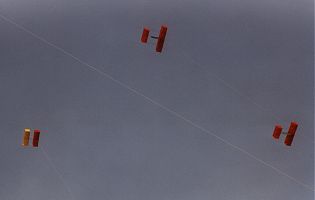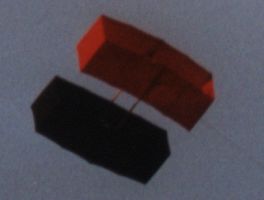Hargrave - Story
A daily came Uwe to me whether I wanted to build not also a Hargrave box kite. This time they should be however from cotton and wood. Said - done. Uwe worried about the preparation of the felling trees hurry and I took over the production of the covering. For preparation I took the structural drawing from the book served "Drachen mit Geschichte" (Kites with History) [2] and in addition an already manufactured kite of our friend Peter. As wood we decided for redwood, because them are nevertheless stable relatively easily however and not necessarily with a glaze had to be given subsequent treatment. The wood was bought as plank and cut in the home workshop of an acquaintance. Afterwards it turned out however that pointed edges are easily fragile. These edges we dipped then short hand into epoxy resin and harden to let. As covering I procured cotton of IKEA in different colors. Against my original project I did not before-wash the material. So far I had also still no intake effects. In addition, the kite was not yet in the rain.

The different colors presented themselves afterwards as easily different qualities, which had as a consequence that the cloths stretched differently much. We did not adapt the woods however, so that we can use the same staffs for each cell. The rear cell is then pressed evenly not completely straight, which is however not detrimental to the flight behavior. To the better stability in all seam edges Kevlar cords drew in. This protects the cloth likewise against strange cords, because Kevlar has a high melting point.

We had not directly taken part in the milled slot into the two longitudinal woods for the diagonal borders at first. That later presented itself as error, because they were to be trained very with difficulty. We had to then clean-burn the recess proper. As all parts together were could the kites be developed. The cloth was sewn onto the wood. In the developed condition the outside edges of the cells drift to each other, so that the kite looked somewhat swept to both sides. We repaired this however meanwhile by an appropriate spanning with Kevlar cords. In addition the wooden strips in the sides of the cells were somewhat weakly laid out. When stretching the cell they do not bend themselves very strongly and the seam-known gotten then to enough tension. With one kite we already exchanged it for thicker borders.